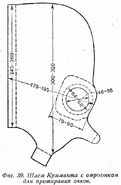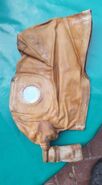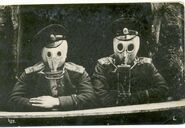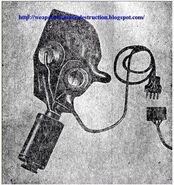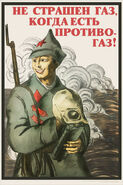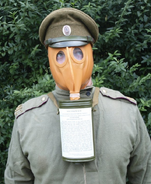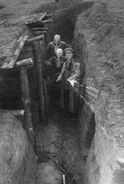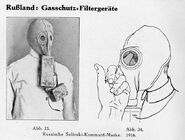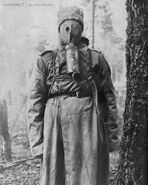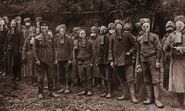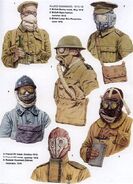The Zelinsky Kummant, also known as the Avalov mask, was designed by Nikolay D. Zelinsky (filter) and Emond Kummant (facepiece). Notable for being the first successful charcoal filtering mask, this gas mask introduced many modern ideas in its design that are still used today such as utilizing activated charcoal filters, as well as being made of rubber for a convenient, quick fit and to create an airtight seal. It is very likely that after the First World War the mask was exported to Romania, Finland and Turkey.
Gas Mask[]
There were two types of facepiece. Both are made of glued light red rubber. The Avalov facepiece had celluloid lenses and a "finger horn" which allowed the user to insert a finger inside to wipe the lenses. The other one, called the Mining Institute or Prince of Oldenburg facepiece, had smaller glass eyepieces and had no "finger horn". Rarely, grey Mining Institute facepieces have been depicted attached to red rubber hoods.
There were three types of filters: Petrogratsky (rectangular), Moskovsky (tall oval) and Kazenny (shorter oval). All had a cap which contained the mask itself, and all contained the same substances. Later during the First World War, Davidovich Joseph Avalov upgraded the Zelinsky-Kummant mask by adding an additional hollow segment to the Petrogradtsky filter, which included an outlet valve. This was prone to damage at first, but was later protected by being hidden within the filter in subsequent redesigns.[1]
After the war, radio operator and rebreather masks were made based on the Zelinsky Kummant.
History[]
In 1915, the need for gas masks arose. A chemist, Nikolay Zelinsky was tasked with creating a gas mask for the Imperial Russian army immediately. Early models of the filter used natrium lime to absorb the gas and let oxygen flow through. However, in 1915[2], Nikolay noticed how activated charcoal was used to filter liquors and implemented this idea into the gas mask. Emond Kummant, an engineer at the Triangle rubber factory in St. Petersburg, designed hermetically sealed rubber gas masks with glass lenses that would be combined with Zelinsky's activated charcoal filtration to create the Zelinsky Kummant mask.[2][3][4]
The Mining Institute facepiece, designed by teachers at the Petrograd Mining Institute, would be tested and found to be difficult to breathe in and provided less protection than the original Zelinsky Kummant masks featuring the Avalon facepiece. Regardless, 6 million of these masks were produced. They would eventually be pulled from production, a decision made on March 19th of 1916 at a Special Conference on Defense meeting where they were deemed "unsuitable"[2] after failing to protect soldiers from a gas attack at the front between Riga and Vilna, resulting in the death of 16,000 soldiers.[5] All masks featuring Mining Institute facepieces were out of use by the end of 1916.
Service[]
Russia and Soviet Union[]
![]() Ру́сская импера́торская а́рмия (Imperial Russian Army)
Ру́сская импера́торская а́рмия (Imperial Russian Army)
From 1916 to 1917, over 11 million Zelinsky-Kummant gas masks were produced for the Imperial Russian Army, despite it comprising of only 6.5 million soldiers.[5]
Romania[]
![]() Armata României (Royal Romanian Army)
Armata României (Royal Romanian Army)
Got masks from Russia as a war effort against Austria-Hungary.
Latvia[]
![]() Nacionālie Bruņotie Spēki (Latvian Defence Forces)
Nacionālie Bruņotie Spēki (Latvian Defence Forces)
Used Zelinsky masks in small numbers alongside with the Small Box Respirator.
Finland[]
![]() Puolustusvoimat (Finnish Army)
Puolustusvoimat (Finnish Army)
In 1929, Finland had 87,500 of these masks, but they were already out-of-date. Despite this, the Army used them in Winter War. Nokia, the later producer of the M/30 and other masks in Finland, made Zelinsky Kummant masks during the First World War because Finland was part of the Russian Empire at that time.
Gallery[]
References[]
- ↑ Gas Mask Lexikon: Zelinsky Kummant
- ↑ 2.0 2.1 2.2 Topwar: "Gas attack king" - February 18, 2015 article
- ↑ Kseniia Pavlova - "On Why Gas Mask Inventor Refused to Patent His Work": December 27th, 2021
- ↑ Paulturner-Mitchell "ZELINSKY-KAASUNAAMARI: KUVAUS, OMINAISUUDET, LUONTIHISTORIA JA ARVOSTELUT" (Zelinsky Gas Mask: Description, characteristics, history of creation and reviews) via Google Translate browser extension
- ↑ 5.0 5.1 Nikolai Dmitrievich Zelinsky's 155th anniversary exhibition at the Artillery Museum: Tabrik.ru summary via Google Translate browser extension

